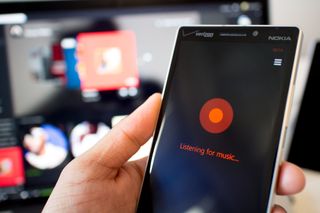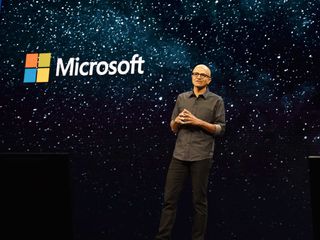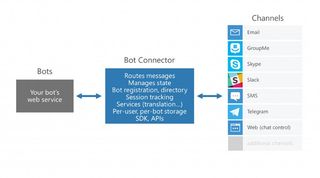Cortana's future is uncertain, but what about Microsoft's bots strategy?
At Build 2016 Microsoft introduced its Conversations as a Canvas strategy where AI and bots were presented as intricately intertwined and important to personal computing's future.

With Cortana's uncertain future, what is the trajectory of Microsoft's bots strategy?
In a multi-device world where a diversity of computing scenarios require an equally diverse means to interact with digital content, bots and AI are beginning to replace humans, apps, and devices for certain scenarios.
Microsoft's Conversations as a Canvas strategy establishes human language as the canvas for our interactions with one another and intelligent systems. This platform incorporates the many ways we use language over a digital medium be it inking/writing, texting/typing or verbal communication. Microsoft's efforts to infuse intelligence into everything from its products and services, IoT, smart speakers and more provides the ether bots and AI use to traverse this digital canvas.
So as smart speakers, and AI battle for our attention, and traditional and Progressive Web Apps (PWA) jockey for position, and Cortana cedes ground to Alexa, where do bots, which are predicted to replace certain types of apps, fit into the grand scheme of things?
What are bots?
Bots are conversation agents or computer programs that communicate like humans. You may have experienced beginning a chat with "someone" that you thought was a human support agent, that turned out to be a bot. A bot's level of human language interaction can be "almost" indistinguishable from a human, and that's the point.
Bots are meant to be intelligent enough to communicate with humans within various scenarios to fulfill our needs. Those scenarios include ordering a pizza or flowers, messaging a contact on our behalf, providing technical support, adding information to our calendars and much more.
Bots can exist on websites and within messaging platforms like Skype or WhatsApp (Microsoft calls these 'canvases'). As intelligent conversation agents, bots can replace apps as we instruct them via text, voice or communication through a meta app like Cortana, to fulfill a particular function. This type of computing scenario is right at home in an increasingly ambient computing and smart speaker-saturated world.
Get the Windows Central Newsletter
All the latest news, reviews, and guides for Windows and Xbox diehards.
Making bots better

Microsoft's vision for bots goes beyond their understanding of human language and following instructions. Through its Cognitive Services Microsoft wants developers to make bots "more human."
Microsoft's Cognitive Services APIs use machine learning to bring advanced AI to apps, websites and bots. The vision API, for instance, can enable bots to recognize a user from a photo. The language API can help bots translate languages, or the knowledge API can enable bots to provide recommendations and other APIs bring other abilities.
130,000 developers have embraced Microsoft's Bots Framework.
The more human and pervasive bots become the more frictionless our interactions with them will be. Though bots won't replace all types of apps, there are many scenarios where through direct or indirect interaction via digital assistants, they will. This is particularly clear as we consider how smart speakers are making us comfortable with directing AI digital assistants to do things for us that we'd normally do via an app, website or PC.

Bot Connector via Microsoft
Microsoft envisions its troubled digital assistant Cortana as a cloud-based meta app that knows us everywhere and across devices. Furthermore, Cortana joins GroupMe, Skype, Slack, Microsoft Teams, SMS and other messaging platforms as a canvas into which thousands of bots can be integrated via Microsoft's Bot Connector.
As Microsoft honors its commitment to bring Cortana to various products in the coming year developers can also bring bots to that "canvas" to extend its abilities. In fact, as of May 2017 130,000 developers have embraced Microsoft's Bots Framework. This is a jump from 45,000 developers just eight months earlier.
Bots in the bigger picture

Modern personal computing allows us to communicate with our digital content in many ways, the effectiveness of which depends on the context. Critics assert bots won't have a place in the modern computing landscape because of the success or potential success of other means of interacting with the digital world. Things are not that black and white, however.
There are a multitude of computing scenarios and interaction methods.
Sometimes inking, such as on Microsoft's intelligent Whiteboard platform may be ideal. In other scenarios, texting via messaging platforms like Skype that are imbued with bots might be the most efficient. Voice commands or queries directed at AI digital assistants like Cortana, Alexa or Assistant may be ideal in other circumstances.
Still, direct interaction with an app, Win32 program or web page may be best in other circumstances. There's no single solution for all scenarios.
AI future...

We live in a world that is a hodge-podge of evolving platforms, tools and computing scenarios for which Microsoft sees AI as an ever-growing part.
Bots won't wholly replace apps, but like PWAs and digital assistants they will continue to subvert apps in some of the scenarios for which we depend on apps today.
And as computing becomes increasingly ambient, AI-driven and "language navigated" Microsoft envisions bots joining digital assistants as increasingly instrumental participants in our computing experiences. After all, in a future that will be increasingly AI-driven bots are AI too.
Further reading
Jason L Ward is a columnist at Windows Central. He provides unique big picture analysis of the complex world of Microsoft. Jason takes the small clues and gives you an insightful big picture perspective through storytelling that you won't find *anywhere* else. Seriously, this dude thinks outside the box. Follow him on Twitter at @JLTechWord. He's doing the "write" thing!

